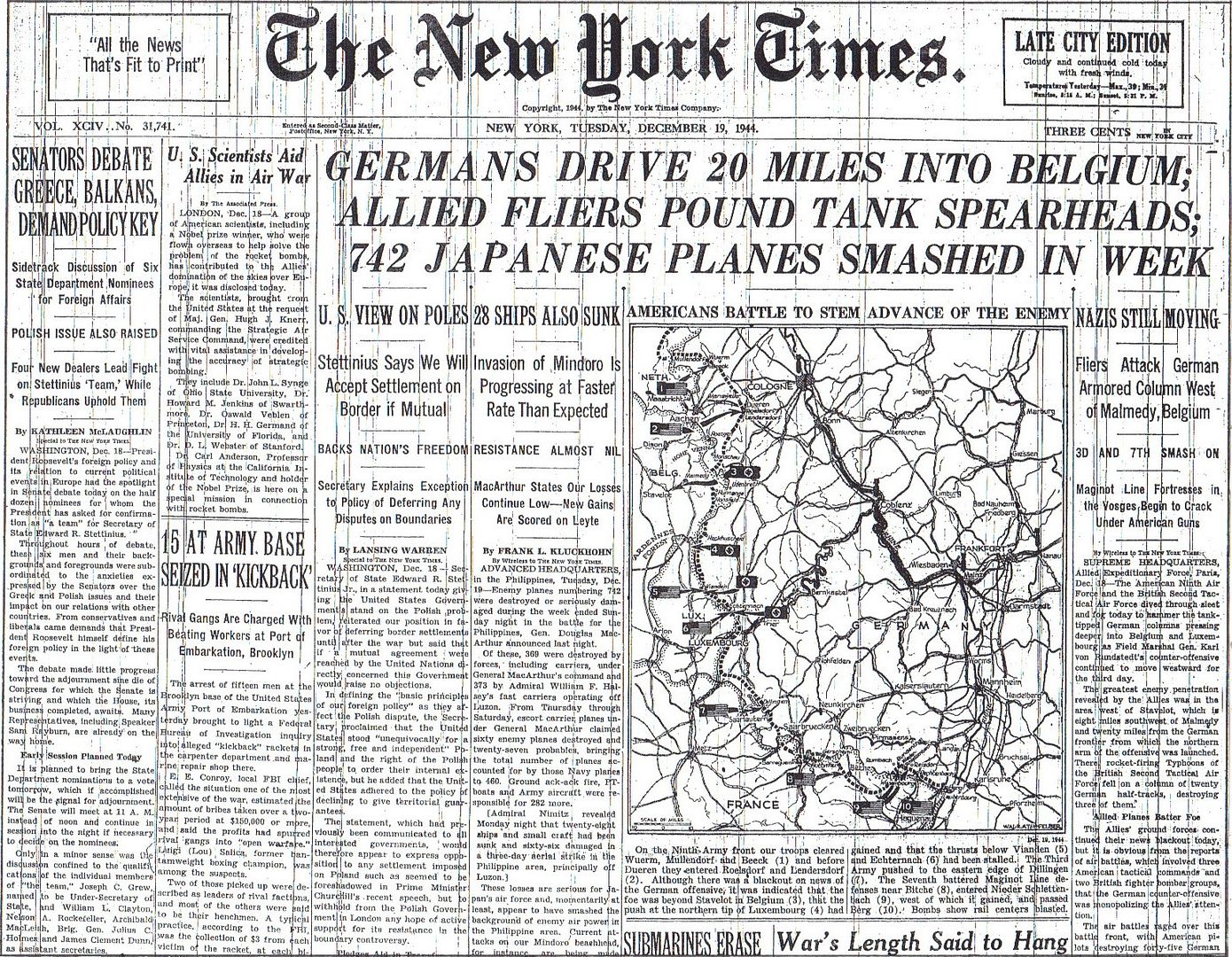
Posted on 12/19/2014 4:36:39 AM PST by Homer_J_Simpson


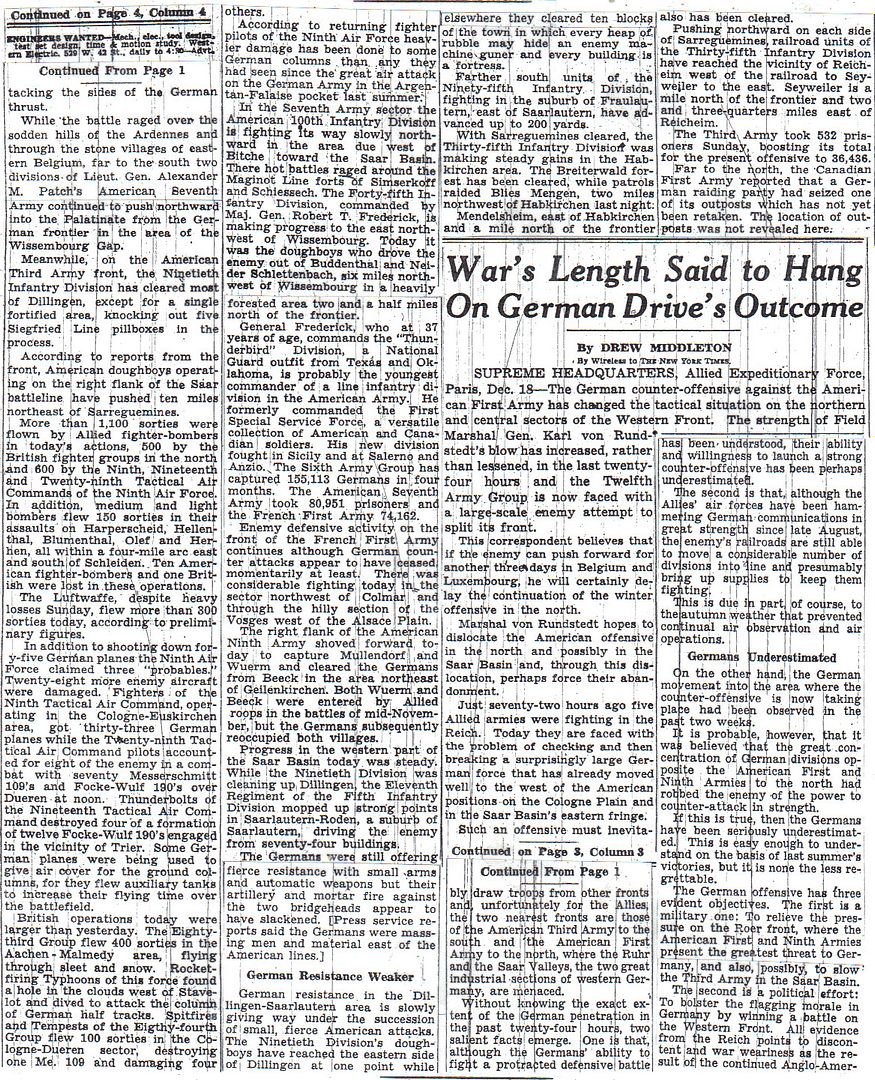
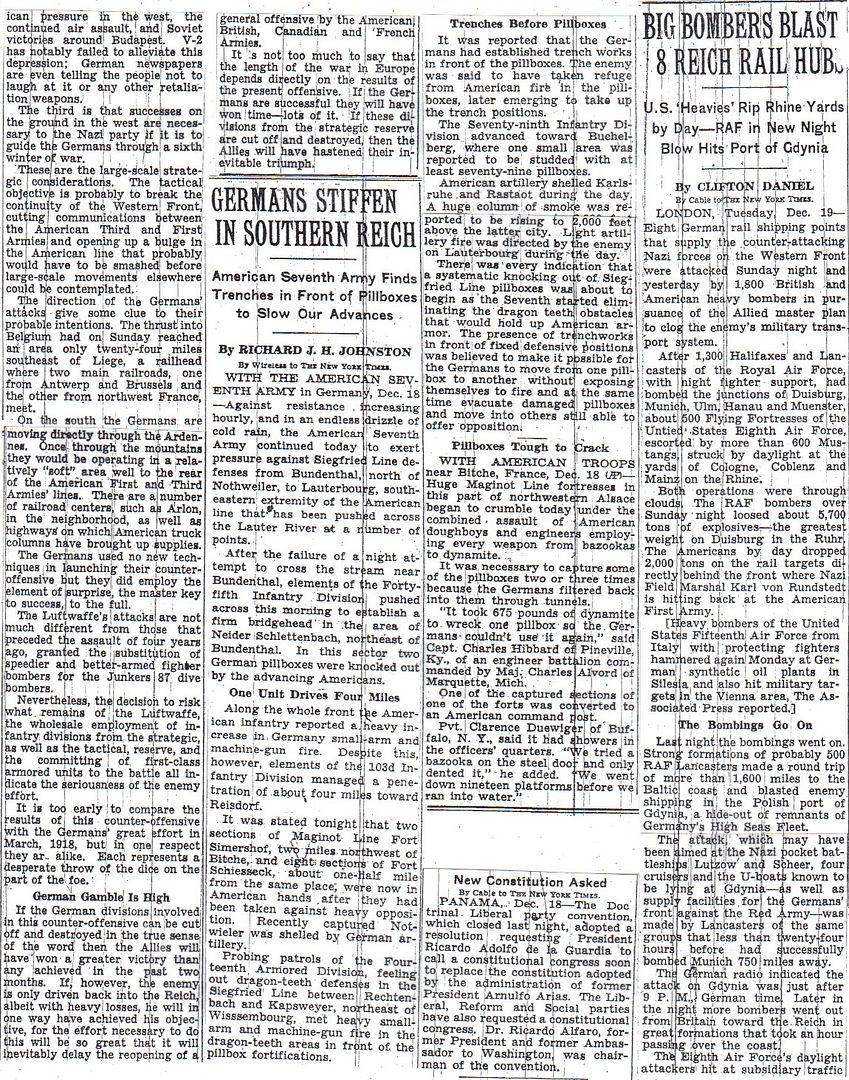

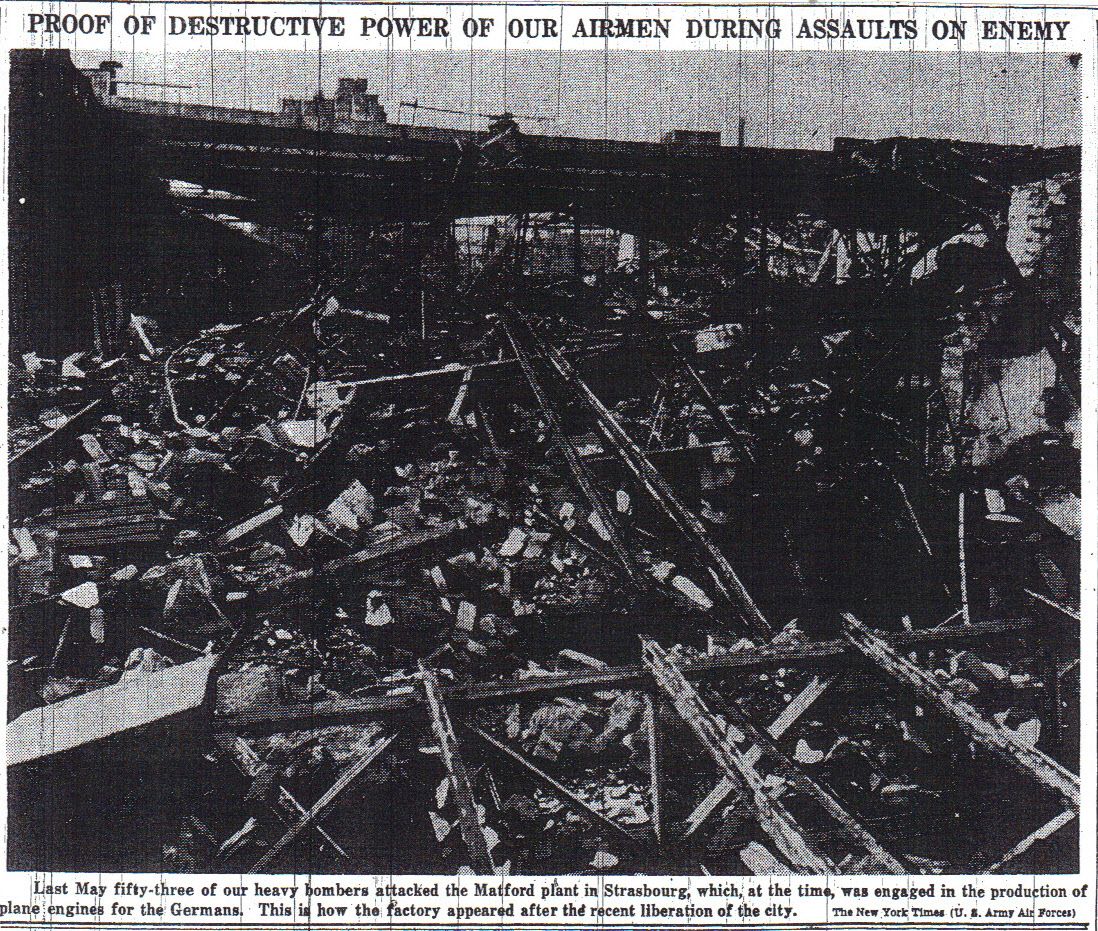
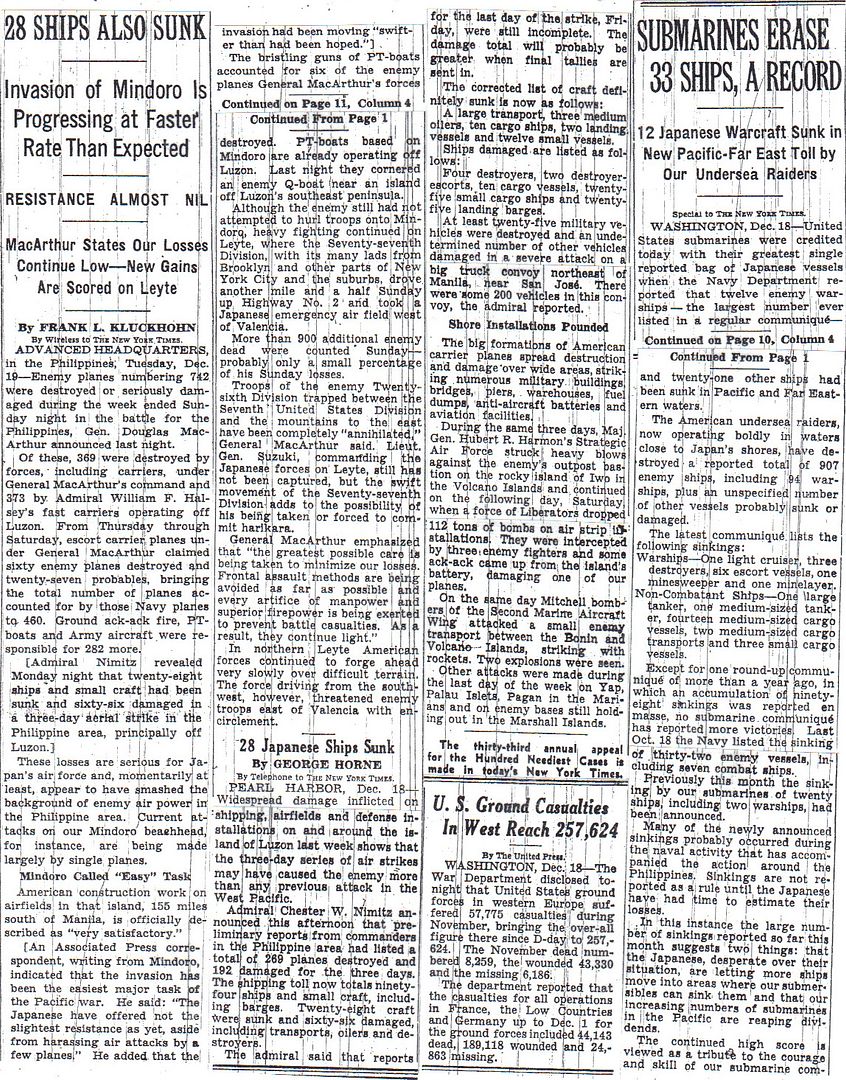
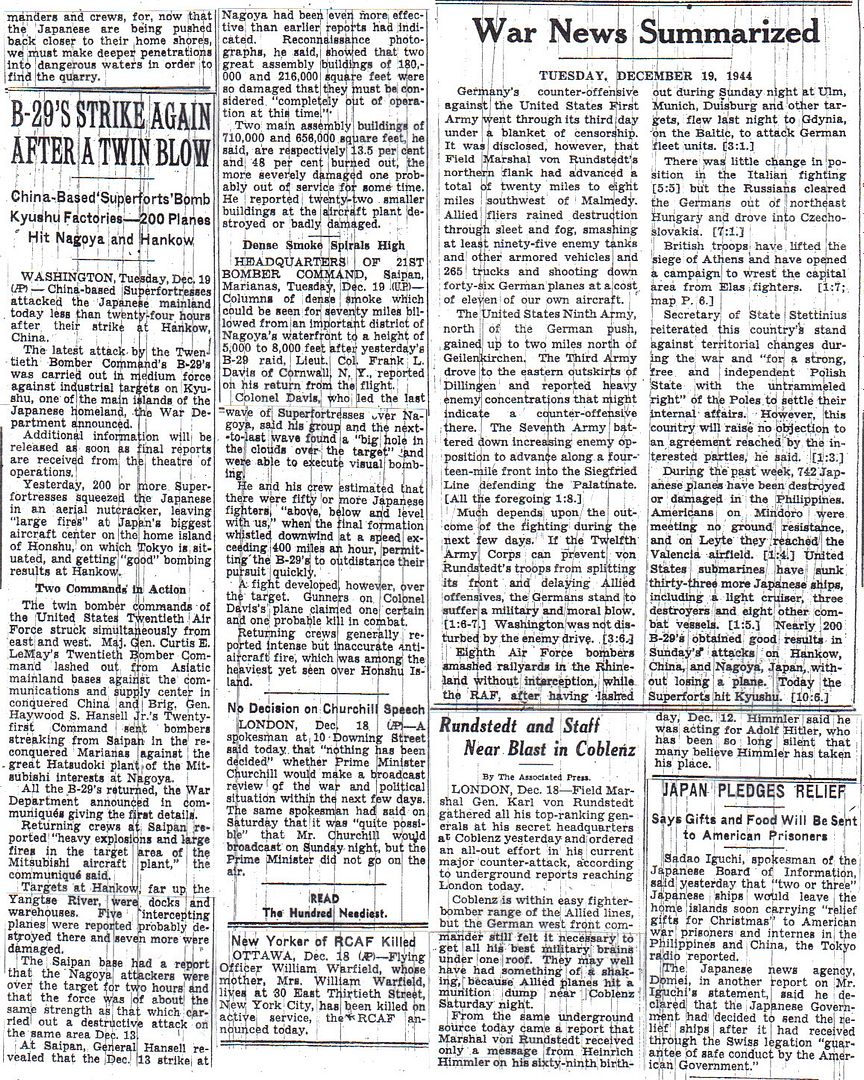
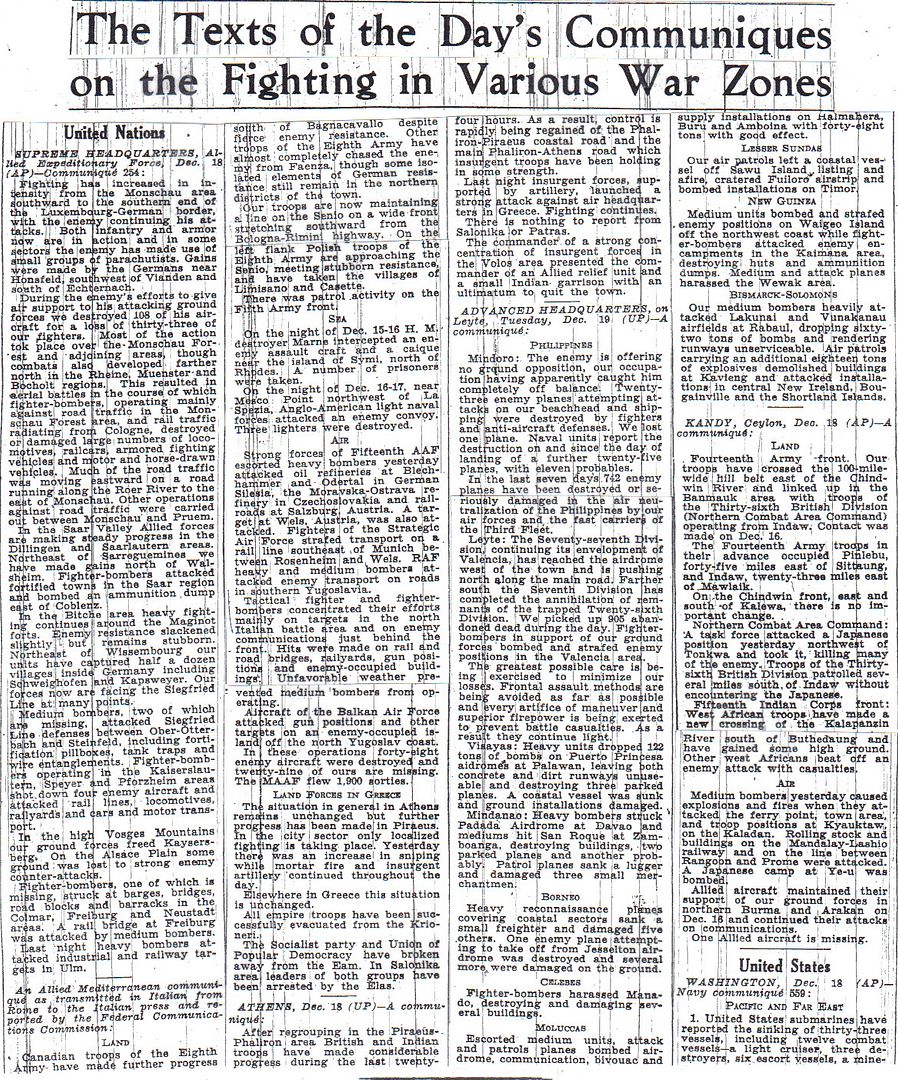
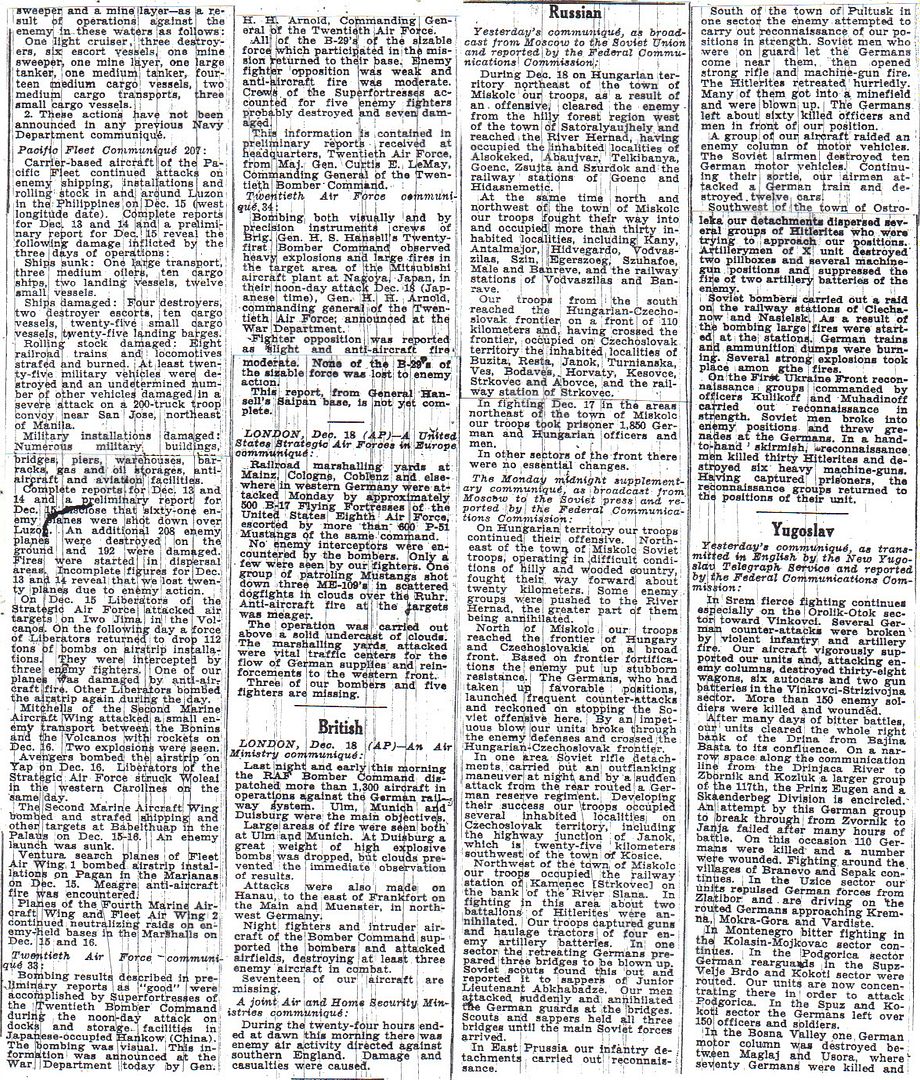

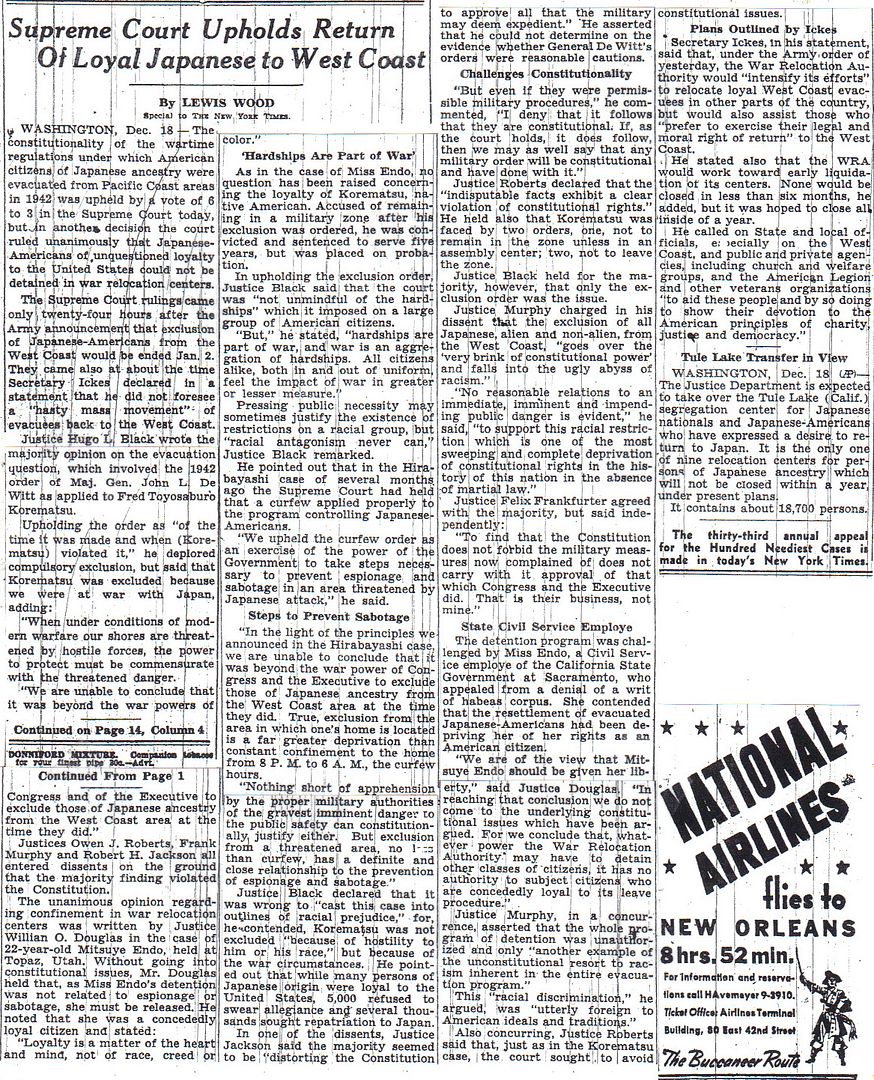
“Elements of the 1st [Japanese] Division had dug in on the top and both sides of a ridge and had utilized caves to construct a defensive position in which there were more than 100 foxholes with communicating trenches. Heavy fighting continued throughout the day. The 1ST Battalion used mortars, flame throwers, white phosphorus grenades, hand grenades, rifles, and supporting flanking fire from its heavy and light machine guns, but was able to advance only seventy-five yards. Although the battalion overran many emplacements, a determined Japanese force remained to be overcome when the battalion established its night perimeter on the eastern slope of the ridge.” (Cannon 341)
The 2D Battalion, 126TH Infantry, met scattered, light resistance and was able to advance 200 yards and secure its area of responsibility by 1200. Throughout the day 2D Battalion was able to provide supporting machine gun and rifle fire for 1ST Battalion's attack to its right. At about 1530 on 19 December, the 2D Battalion was relieved by 1ST Squadron of the 112TH Cavalry Regiment and moved to an assembly area to the rear. The 112TH Cavalry had been conducting operations in support of the 1ST Cavalry Division's advance further to the east and had also been protecting the 32D Division's left flank.
By nightfall on 19 December, Co. B, 126TH Infantry, which had encountered the most stubborn opposition in 1ST Battalion's area, had one platoon established on the east side of the ridge, another platoon on the west side, and the remainder of the company to the south. Throughout the night Co. B was able to keep constant pressure on the Japanese position, by firing on it from 3 sides. “At dawn, and without breakfast, the company rushed the position and by 1000 had complete control of the area. Two hundred Japanese dead were found. (Blakeley 197)”
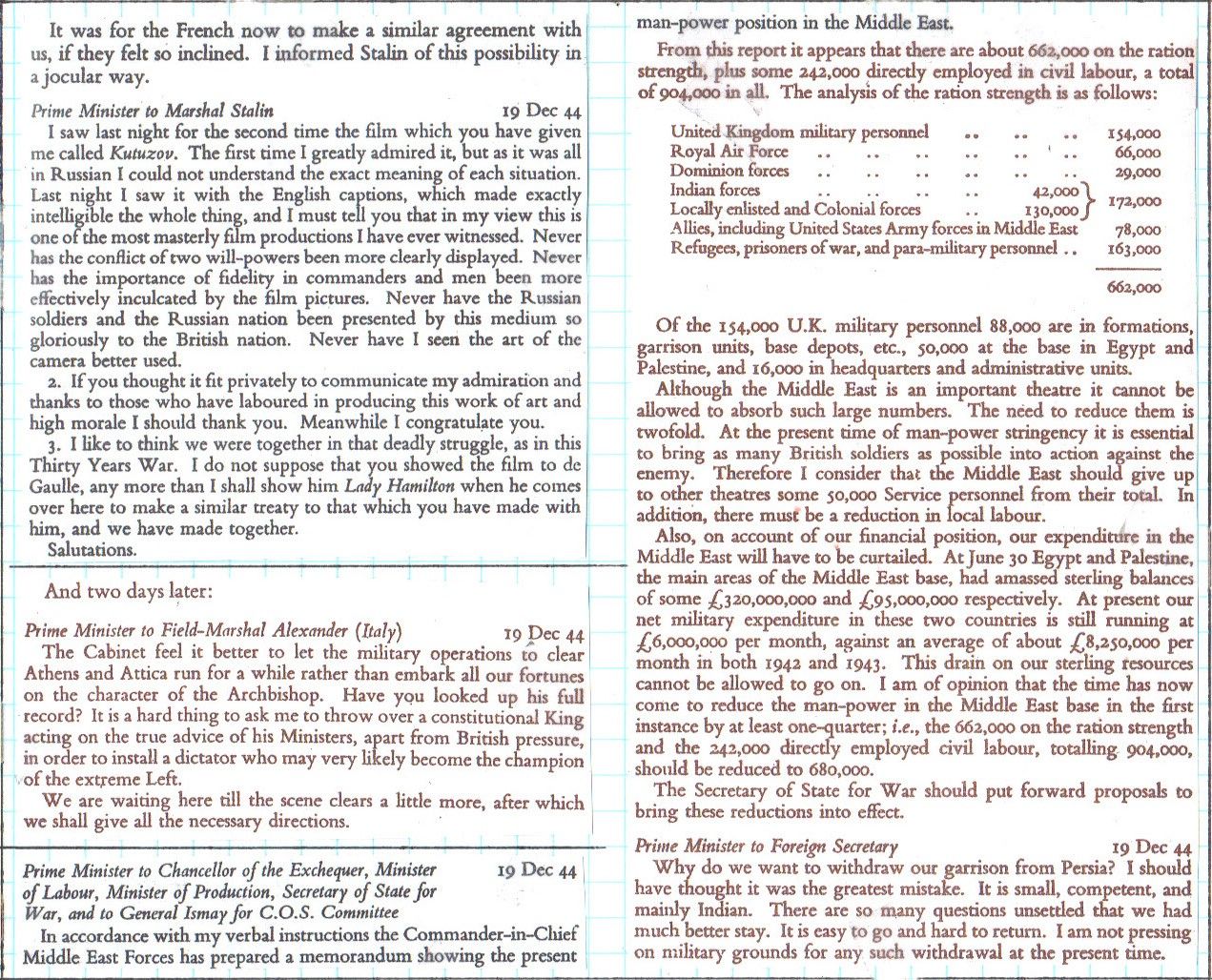
Winston S. Churchill, Triumph and Tragedy
http://www.etherit.co.uk/month/11/19.htm
December 19th, 1944 (TUESDAY)
UNITED KINGDOM: Weather grounds the USAAF Ninth Air Force bombers. Fighters fly armed reconnaissance in western Germany, escort RAF Lancasters, fly patrols from Belgium to the Rhine River, support the U.S. 1st, 2d, 99th, and 106th Infantry Divisions, and 7th Armored Division (north and east of Malmedy, Belgium, and southeast and southwest of Saint-Vith, Belgium), and fly cover for U.S. Twelfth Army troops and the XII Corps near Verdun and Saint- Avold, France.
EIRE: An RAF Catalina Mk. IV assigned to No. 202 Squadron, RAF Coastal Command based at RAF Castle Archdale, County Fermanagh, Northern Ireland, crashes on Stradbally Mountain, County Kerry. The wreckage is finally removed in 1978.
FRANCE: Versailles: Confined to his headquarters office by assassination threats, Eisenhower gives temporary command of the US First and Ninth Armies to Montgomery. Montgomery and Bradley are placed in command of the northern and southern sectors of the German offensive. A public announcement of this move will not occur until 5th January, 1945.
Late in the evening of 19 Dec Eisenhower studied the situation map in his office and drew a line from Givet, on the Muese River through the Ardennes and across the German frontier to Prum. All Allied units north of the line were placed under command of Montgomery which meant that he commanded the US First and Ninth Armies. South of the line Bradley would command the US Third Army. He ordered that the change take effect on 1200 of 20 Dec.
This was a meeting of American, not Allied, commanders. No British commanders were present, although Montgomery was represented by his chief of staff de Guingand which meant that the British did not want their presence to complicate matters. At the meeting Patton was ordered to attack toward Bastogne with the newly designated III Corps, commanded by Major General John Millikin. III Corps was to advance north toward St. Vith. Three divisions were attached to the corps: the 80th Infantry Division was on the right and maintained contact with XII Corps. The 26th Infantry Division was in the center, and the 4th Armored Division on the left. Bastogne was in its zone. This was the initial combat for Headquarters, III Corps and its commander, General Millikin. All of its attached divisions had been seen combat.
While the mission of the 101st Airborne Division and attached units was to defend Bastogne, the digging in was done at positions five to seven kilometres from Bastogne.
The Germans reach Stavelot and Houffalize areas, with US forces holding their ground in between near Gouvy and St. Vith. The US 82nd Airborne will hold Houffalize for several days, while the US 101st Airborne digs in at Bastogne.
The fog of war was at its height during the initial days of the Battle of the Ardennes. When the 82nd and 101st were released to VIII Corps, Major General Troy Middleton, the commander, intended to employ the 101st at Bastogne and the 82nd at Houffalize. However, as the post above indicates the Germans were already at Houffalize. At this time First Army became concerned about the advance of Kampfgruppe Peiper and so the 82nd was attached to V Corps on the northern side of the German penetration and assembled at Werbomont. (Jay Stone)
The U.S. Seventh Army is ordered to go on the defensive. In the XV Corps area, the 44th Infantry Division finds that the Germans have abandoned Fort Simershof and Hottviller. Fort Schiesseck, barring access to Bitche, continues to hold out.
BELGIUM: SS troops under Lieutenant-Colonel Joachim Peiper massacre 130 civilians who they claim were harbouring US soldiers.
Because of the German Ardennes counteroffensive, Field Marshal Bernard Montgomery, Commander in Chief 21st Army Group, abandons a plan to employ XXX Corps, British Second Army, in the Nijmegen, The Netherlands, area and orders it to assemble in the Louvain-St Trond-Hasselt region to hold the Meuse River line.
The Germans reach the Stavelot and Houffalize areas, with U.S. forces holding their ground in between near Gouvy and St. Vith. The U.S. 101st Airborne Division digs in at Bastogne. While the mission of the 101st Airborne Division and attached units is to defend Bastogne, the digging in was done at positions five to seven kilometers (3.1 to 4.3 miles) from Bastogne. (John Nicholas and Jay Stone)
In the U.S. First Army area, VII Corps remains generally in place. In V the Corps area, the 2d and 99th Infantry Divisions repel further attacks and start toward new defensive positions from which they will defend the Elsenborn ridge. The 9th Infantry Division (less Regimental Combat Team 47 which is already in the corps zone, and Regimental Combat Team 6o) takes up defensive positions in the 2d Infantry Division zone, relieving elements of the 2d and 99th Infantry Divisions. The 1st Infantry Division holds the line east of Malmédy. Combat Command A, 3d Armored Division, relieves the 18th Infantry Regiment, 1st Infantry Division, of the defense of Eupen. The 30th Infantry Division holds at Stavelot and engineers blow a bridge across the Ambleve River there; this keeps the Germans from Stoumont in a costly battle. Combat Command B, 3d Armored Division, is attached to the corps to assist the 30th Infantry Division. The XVIII Corps (Airborne) takes responsibility for the r egion generally south of the Ambleve River, including Houffalize, a key road center between St Vith and Bastogne, with the mission of holding the northern flank of the Germans. The 82d Airborne Division, which reverts to the corps, upon closing at Werbomont relieves the 30th Infantry Division troops in that region. The 3d Armored Division, less Combat Command A and B, passes to corps control and starts toward the Hotton-Le Grand Pré area. In the VIII Corps area, hope of relieving the beleaguered 422d and 423d Infantry Regiments of the 106th Infantry Division in the Schnee Eifel fades. The 7th and 9th Armored Divisions (-) are aggressively defending the region just east of St Vith. The 112th Infantry Regiment, 28th Infantry Division, is attached to the 106th Infantry Division. The28th Infantry Division is ordered to abandon Wiltz and return to friendly lines by infiltration withdraws from Diekirch area. The 101st Airborne Division arrives at Bastogne, which the Germans have almost encircled. Also employed in the defense of the Bastogne area are Combat Command B of the 10th Armored Division and remnants of Combat Command R, 9th Armored Division, the latter coming under control of the 101st Airborne Division.
LUXEMBOURG: The U.S. Third Army forms a provisional corps from former First Army units south of the Ardennes salient, the 4th Infantry Division and the 10th Armored Division (- Combat Command B); the corps is to hold the Germans on the south flank of the penetration and plug a gap existing between it and elements of the 9th Armored Division and 28th Infantry Division near Ettelbruck.
NORTH SEA: U-737 sank in Vestfjorden, position 68.09N, 15.39E, after a collision with MRS 25. 31 dead and 20 survivors.
BALTIC SEA: During the night of 19/20 December, 12 RAF Bomber Command Lancasters lay mines in the Cadet Channel, the strait between Storstrom Island, Denmark, and Germany.
GERMANY:
The U.S. Third Army’s XX Corps begins withdrawal from hard-won positions east of the Sarre River. The 5th Infantry Division maintains a foothold east of the river at Saarlautern, but the 378th Infantry Regiment, 95th Infantry Division, is ordered to withdraw from Ensdorf. The III Corps is ordered north for an attack against the southern flank of enemy in the “Bulge.†In the XII Corps area, the 35th Infantry Division halts an attack to consolidate in preparation for relief. The 4th Armored Division and 80th Infantry Division are being transferred to III Corps.
The USAAF Eighth Air Force flies Mission 756: 328 bombers and 45 fighters are dispatched to hit tactical targets (rail and road junctions, rail and road chokepoints and railheads) to impede the German counteroffensive launched in the Ardennes: 65 aircraft hit the Ehrang marshalling yard (M/Y) at Trier, 49 bomb a railroad junction at Kall, 40 attack Kyllburg, 28 hit the M/Y at Gemund, 25 bomb Blankenheim, 23 attack Bitburg, 22 bomb Hildersheim, 13 each bomb the Lutzel M/Y at Koblenz and a highway choke point at Schleiden, 12 attack a highway choke point at Glaadt and nine bomb Stadtkyll. The missions above are escorted by 37 P-47 Thunderbolts; they claim 7-0-1 Luftwaffe aircraft.
USAAF Fifteenth Air Force bombers attack oil and rail targets: at Blechhammer, 114 bomb the North I.G. Farben synthetic refinery and 47 hit the South refinery with the loss of five aircraft; at Rosenheim, 26 hit the West marshalling yard and 24 hit the Main marshalling yard; one other aircraft bombs Kassel.
During the day, 30 RAF Bomber Command Lancasters, escorted by USAAF Ninth Air Force P-47 Thunderbolts, carry out a G-H raid on the railway yards in Trier behind the front on which the Germans are attacking in the Ardennes.
U-2356 launched.
AUSTRIA: USAAF Fifteenth Air Force bombers hit rail targets: 35 bomb the Stroszhof marshalling yard (M/Y) in Vienna, 28 hit the Main M/Y at Graz, 19 bomb the South M/Y at Villach and two hit the North M/Y, 16 bomb the Main M/Y at Innsbruck and 14 bomb the North M/Y at Klagenfurt.
CZECHOSLOVAKIA: Seven USAAF Fifteenth Air Force bombers bomb a synthetic oil refinery at Ostrava Moravaska and three other bombers hit targets of opportunity.
ITALY: In the British Eighth Army area, V Corps, renewing their offensive during the night of 19/20 December, clears the Faenza area sufficiently for deployment of the 56th Division. The Canadian I Corps begins an attack, during the night of 19/20 December to break out of the Naviglio Canal bridgehead.
Weather grounds USAAF Twelfth Air Force medium bombers. XXII Tactical Air Command fighters and fighter-bombers, unable to reach the primary targets further north, hit communications north of the battle area but concentrate mainly on gun positions in the La Spezia area. During the night of 19/20 December, A-20 Havocs attack lights at five locations in the eastern Po Valley.
GREECE: RAF Air Headquarters Greece at Kifisia is attacked by Communist Hellenic People’s Army (ELAS) troops. Despite the best efforts of No.2933 Squadron RAF Regiment, the headquarters is overrun tomorrow and a large number of British prisoners are taken and marched north. Supplies are dropped to the column by Wellington Mk. XIIIs of No.221 Squadron RAF.
YUGOSLAVIA: Forty nine USAAF Fifteenth Air Force bombers bomb two marshalling yards in Maribor with the loss of one aircraft.
During the day, RAF bombers of No. 205 (Heavy Bomber) Group bomb three targets: 36 bomb tactical targets at Kolasin, 12 hit the West marshalling yard at Sarajevo and four attack a highway bridge at Matesevo.
CHINA: Sixteen USAAF Fourteenth Air Force B-25 Mitchells, escorted by 24 P-40s, attack Pengpu. Four P-51s claim two freighters sunk off Hong Kong and two P-40s destroy three locomotives and a truck at Sinyang.
BURMA: In the British Fourteenth Army’s IV Corps area, the Indian 19th Division takes Wunthe. In the XXXIII Corps area, the British 2nd Division, having moved forward from Kohima, crosses the Chindwin River at Kalewa and is relieving the East African 11th Division.
Twelve USAAF Tenth Air Force B-25 Mitchells hit road junctions at Mongmit and south of Kyaukme, the Kyaukme railroad station, and Hsenwi bridge. Seven P-47 Thunderbolts severely damage the Tonbo road bridge, and 11 others hit targets of opportunity during a Onmaka-Hsoplong rail sweep. Forty two P-47s attack supply and personnel areas and troops at Myadaung, Tantabin, and Twinnge, the village of Nyaugbintha, and a truck park near Humon.
Four USAAF Fourteenth Air Force P-38 Lightnings bomb the Wanling-Mongyu road causing a traffic block.
JAPAN: The USAAF Twentieth Air Force’s XX Bomber Command flies Mission 22: 36 B-29 Superfortresses, from the Chengtu, China area, are dispatched to hit an aircraft plant at Omura; 17 hit the primary target and 13 others hit secondary target, Shanghai, China, and another two strike other alternates; they claim 5-4-12 Japanese aircraft; two B-29s are lost.
VOLCANO ISLANDS: Twenty seven USAAF Seventh Air Force B-24 Liberators from Saipan and 25 from Guam, Mariana Islands, strike Iwo Jima. Fourteen P-38 Lightnings from Saipan, with three Twentieth Air Force XXI Bomber Command B-29 Superfortresses as navigational escort, strafe airfields on Iwo Jima. Four B-25 Mitchells from Guam and Saipan carry out three snooper strikes against Iwo Jima during the night of 19/20 December.
PACIFIC OCEAN: In the East China Sea, the Japanese aircraft carrier HIJMS Unryu is torpedoed and sunk by the USN submarine USS Redfish (SS-395) about 204 nautical miles (379 kilometers) northwest of Naha, Okinawa, in position 28.19N, 124.40E. This was the first war voyage for HIJMS Unryu. The ship is carrying a special cargo of 30 Yokosuka MXY7 Navy Suicide Attacker Ohka (Cherry Blossom) Model 11 rocket propelled suicide aircraft before being sent on her way to confront the U.S. invasion forces in the Philippine Islands. The first torpedo strikes Unryu on the starboard side under the bridge; the second torpedo struck 15 minutes later under the forward elevator setting off the deadly Ohka bombs and aviation gas stored in the lower hanger deck. The detonations literally blows the bow area apart. After the boiler rooms flood, the ship lists to over 30 degrees and the order to abandon ship is given. Minutes later, with a 90 degree list, the carrier plunges headfirst into the wate r. There are only 147 survivors of the 1,241 crew plus an unknown number of passengers. Redfish is damaged in the resultant depth charging, and is forced to terminate her patrol.
COMMONWEALTH OF THE PHILIPPINES: While the fighting on Leyte, continues, the Japanese high command decides that no more reinforcements or supplies will be sent to the 35th Army.
In the U.S. Army’s X Corps area on Leyte Island, the 127th Infantry Regiment, 32d Infantry Division continues to battle the Japanese south of Limon. The 12th Cavalry Regiment (Infantry), 1st Cavalry Division, attacks toward Lonoy, on Highway 2, and seizes this barrio. In the XXIV Corps area, the 307th Infantry Regiment, 77th Infantry Division attacks north astride Highway 2 toward Libongao, gaining nearly 3 miles (4,8 kilometers); the 306th Infantry Regiment to the west pushes toward the Palompon road, which patrols reach. On Mindoro Island, the Western Visayan Task Force, helped by Mindoro guerrillas, begins a series of patrol actions along the south, west and northwest shores of Mindoro and a reconnaissance of small islands offshore.
USAAF Far East Air Forces fighter-supported B-25 Mitchells bomb Fabrica Airfield on Negros Island. Fighters on a sweep over Ponay, and Leyte Islands hit Fabrica, Bacolod, Silay, Dumaguete and Alicante Airfields, and the town of Palompon on Leyte Island. On Luzon, B-24 Liberators bomb Legaspi Airfield while P-38 Lightnings hit Batangas Airfield.
The planned bombardment of Luzon by the large carriers of U.S. Third Fleet is canceled because of weather conditions.
NEW GUINEA: Australian Lieutenant General Frank Berryman, Chief of Staff Advanced Headquarter Allied Land Forces South West Pacific, is convinced that U.S. Lieutenant General Richard Sutherland, Chief of Staff South West Pacific Area, is trying to hinder Australian liaison with General Headquarters, and sends a message to U.S. General of the Army Douglas MacArthur, Commander in Chief South West Pacific Area, stating: “General (Thomas) Blamey (Commander in Chief Allied Land Forces South West Pacific and Commander in Chief Australian Military Force) desires direct liaison and would appreciate attachment of Lieutenant General Berryman and small personal staff to Advanced General Headquarters (at Hollandia) as early as convenient to you.”
MARCUS ISLAND: Three USAAF Seventh Air Force B-24 Liberators on armed reconnaissance from Guam bomb Marcus Island. The island is located in the North Pacific about 768 nautical miles (1 422 kilometers) west-northwest of Wake Island and is used as a refueling point for Japanese aircraft en route to the Central Pacific.
EAST INDIES: In the Netherlands East Indies (NEI), USAAF Far East Air Forces B-25 Mitchells, A-20 Havocs, and P-38 Lightnings attack the Kairatoe area on Celebes Island. Other FEAF aircraft on armed reconnaissance, sweeps, and small strikes hit targets of opportunity at many locations throughout the NEI.
U.S.A.: Washington: Chester W. Nimitz is promoted to Fleet Admiral.
A 3 by 4 feet (0,9 by 1,2 meter) piece from a paper Japanese Fu-Go balloon is found at Manderson, Wyoming. The date of the landing cannot be determined. Manderson is located about 105 miles (169 kilometers) south of Billings, Montana.
Four fighters of the USAAF Fourth Air Force, directed by the Los Angeles Control Group to search for a Japanese Fu-Go balloon reported over Santa Monica, California, are unable to locate the target.

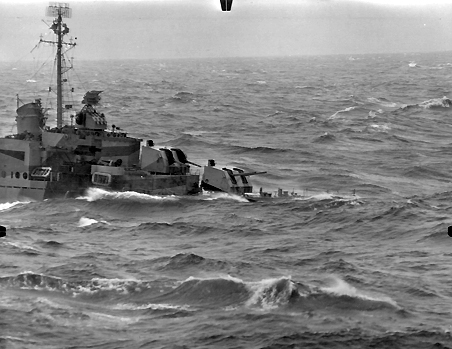
_during_Typhoon_Cobra,_December_1944.jpg)
In addition to Spence and Monaghan, USS Hull (DD-350) was also sunk.
This link has a number of pages related after action reports on the typhoon:
http://www.history.navy.mil/faqs/faq102-4.htm
LMAO! I can see that happening!
I notice that “today” - 3 days after the Battle of the Bulge started - the news was still censored (in part because the US commends were just figuring out what was going on too),, but the “name” Battle of the Bulge wasn’t yet being used.
Notice the Polish question (Cold War) had already started? See page one of the paper!
The Empire Strikes Back.
Atkinson’s, The Guns at Last Light....
With Skorzney and his cutthroats presumed to be still at large, Eisenhower reluctantly agreed to move from the St.-Germain villa to smaller quarters near his office. Each day his black limousine continued to follow the same route to and from SHAEF headquarters, but with the rear seat occupied by a lieutenant colonel named Baldwin B. Smith, whose broad shoulders, prominent pate, and impatient mien made him a perfect body double for the supreme commander.
The real Eisenhower, traveling with Tedder in a bulletproof Cadillac first used in Africa, arrived in Verdun for a war council on Tuesday morning, December 19. At an ancient French Army barracks within a muddy quadrangle, he was joined by Bradley, Jack Devers, and Patton, who drove up smoking a cigar in a jeep with plexiglass doors and a .30-caliber machine gun mounted on a swivel. At 11:30 a.m. they climbed upstairs to a dank stone squad room with a single potbellied stove, a large table, and a map unfurled across a wall. Bradley, already in a testy mood, pointed to a red arrow labeled “20 German tanks” approaching Namur on the Meuse, farther west than previously reported. “What the hell is this?” he demanded. An intelligence officer hurried to the map, snatched off the errant marker, and appoligized for the error.
“The present situation is to be regarded as one of opportunity for us and not of disaster,” Eisenhower said, setting into his chair. From the other end, Patton chimed in, “Let’s have the guts to let the bastards go all the way to Paris. Then we’ll cut ‘em off and chew ‘em up.”
Two staff officers reviewed the battlefront in detail. At least seventeen German divisions had joined the attack already; the identities of most were known. The heaviest pressure could be felt at St.-Vith and Bastogne, two vital road centers. Atrocities had been documented. Daily Luftwaffe sorties over St.-Vith had declined sharply from six hundred on Sunday, although a persistent overcast also had grounded Allied planes. Seven French infantry battalions would help defend the Meuse, along with half a dozen COMZ engineer regiments. American strength had doubled since Saturday, to about 180,000 troops in ten infantry and three armored divisions. More would soon follow.
Eisenhower then spoke. “Devers 6th Army group would assume the defensive in Alsace,” he said, “and contribute reserves for the Ardennes.” Scattered forces must be pulled together for a ‘positive concerted action.” Holding the high ground south of Liege would keep supply depots outside enemy artillery range. By squeezing the shoulders of the German salient, shoring up the Meuse, blunting the enemy advance, and creating “a supply desert,” they could smash Rundstedt’s bulge - as it was now called - with an American counterblow again aimed at the Rhine. Third Army, which currently held an eighty-mile front with three corps facing the Saar, would pivot north to knife into the exposed German left flank.
Peering down the long table at Patton, Eisenhower asked in his booming voice, “George, how soon can you get an attack off?”
“On December 22,” Patton replied, “with three divisons - the 4th Armored, the 26th, and the 80th.”
Leaning forward, Eisenhower quickly calculated space, time, and divisions on his fingers. The maneuver required making a sharp left turn with a full corp, then moving nearly a hundred miles over winter roads. “Don’t be fatuous George. If you try to go that early, you won’t have all three divisions ready and you’ll go piecemeal,” he said. “I’d even settle for the 23rd if it takes that long to get three full divisions.”
“I’ll make a meeting engagement in three days,” Patton said, “and I’ll give you a six-division coordinated attack in six days.” Someone chuckled. The uneasy shuffle of boots could be heard on the bare floor. Glancing at a staff officer for confirmation, Patton added, “We can do that.”
Before leaving the barracks, Patton phoned his headquarters to issue various movement orders: XII Corps was to wheel toward Luxembourg in tandem with III Corps drive to Belgium. “Everyone is a son-of-a-bitch to someone,” he told his staff by was of encouragement. “Be better sons-of-bitches than they are.”
Eisenhower declined Bradley’s invitation to stay for lunch; he would eat a sandwich in the Cadillac on the way back to Versailles. Turning to Patton before getting into the car, Eisenhower said, “George, every time I get promoted, I get attacked.”
Patton chuckled, “Yes, and every time you get attacked, I bail you out.”
Great post.
reading it now ... an EXCELLENT account of the Bulge ...
Nice catch, but where is it? Thanks RACPE.
There’s another story on the SCOTUS ruling regarding Japanese detainees.
I didn't save the article. I figured I would have my hands full preparing Battle of the Bulge items.
(I was right.)
First page of the NY Times. The post-war borders and priorities and (future Cold War) international issues of Greece, Balkans, Poland, and the MidEast is mentioned twice in the headlines actually: column 1, and again column 3.
Stalin was fighting the Cold War in 1944. 3 years before Churchill noticed, and almost a decade before we stalemated in Korea, lost Eastern Europe, China, north Korea, Yugoslavia ....
Also from Atkinson’s The Guns Last Light:
Eisenhower had urged his lieutenants in Verdun “to avoid any discouragement or feelings of disappointment in the changes situation.” However, a new development left Bradley not only discouraged and disappointed but also furious.
British intelligence on Tuesday evening concluded that the road to Namur was in fact vulnerable, and if German shock troops crossed the Meuse there they could reach Brussels within hours. Montgomery confided to Brooke that he had told SHAEF’s deputy operations officer, Major General J.F.M. Whiteley. “that Ike ought to place me in operational command of all troops on the Northern half of the front. I consider he should be given a direct order by someone to do so.” In Versailles, Whiteley and Major General Strong, also British, agreed that the Ardennes battlefield would best be managed by two commanders - Montgomery in the north and Bradley in the south - rather than by 12th Army Group alone.
Bradley’s subordinate generals to the north were frustrated by their commanders isolation, which allowed only fitful telephone and radio contact; they also complained that not a single staff officer from the army group had visited First Army, Ninth Army, or their affiliated air forces since the offensive began on Saturday. When Eisenhower had proposed that 12th Army Group shift its headquarters to a more central locale, Bradley absurdly replied, “That would startle the people of Luxembourg too much. They would think we were defeated and had to get out.”
Rousted from his bed by Whiteley and Strong on Tuesday night, Beetle Smith listened to their proposal to expand Montgomery’s role and their warnings of “further deterioration” at the front. Then he rounded in anger on the staff officers. Clearly these two Britishers did not consider the Yanks capable of handling this crisis, Smith charged. Where did their loyalties lie? Such faithless impertinence was intolerable. Both men should consider themselves relieved of their duties, and return to England immediately.
As Whiteley and Strong slunk away in the face of this tirade, Smith phoned Eisenhower, finding the supreme commander still in his office at eleven p.m. Fuming, Smith described the bifurcation proposal while grudgingly conceding that it had merit: among other benefits, Montgomery would more likely commit British reserves to the battle if he commanded them. Eisenhower, staring at a huge wall map promptly agreed. With a grease pencil he drew a line on the map from Givet on the Meuse east through the Ardennes to Prum in Germany. St-Vith fell north of the line, Bastogne south.
While the supreme commander pondered this demarcation, Smith phoned Bradley in Luxembourg City:
“Ike thinks it may be a good idea to turn over to Monty your two armies in the north and let him run that side of the Bulge from 21st Group....It seems the logical thing to do. Monty can take care of everything north of the Bulge and you’ll have everything south.”
Bradley answered cautiously. He noted that no hint of this scheme had arisen in Verdun that morning. Although three enemy armies were now interposed between his command post and the bulk of his army group to the north, he considered his communication difficulties insignificant. “I’d question whether such a change-over is necessary,” he added.
...continued tomorrow.
Disclaimer: Opinions posted on Free Republic are those of the individual posters and do not necessarily represent the opinion of Free Republic or its management. All materials posted herein are protected by copyright law and the exemption for fair use of copyrighted works.